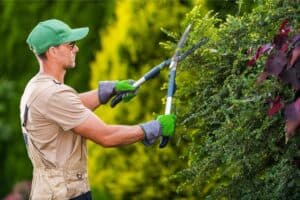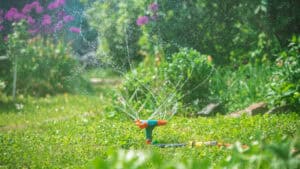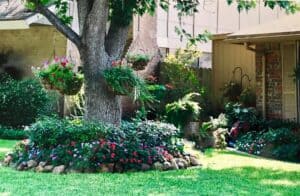July in Tampa doesn’t just mean sunshine and warm nights. It also means downpours, rising humidity, and the type of heavy rain that can quickly turn your dream landscape into a soggy, flooded mess. For homeowners who have poured time and money into their outdoor space, this season can be a serious test. It’s not just about muddy puddles or washed-out mulch. It’s about protecting your investment, everything from your plants to your soil to the very structure of your property.
At LS Gardens, we’ve seen firsthand how quickly a landscape can suffer without a proper drainage plan in place. It’s not a flashy topic, but it’s one of the most important conversations we have with our clients each summer. When rain comes down fast and hard, as it often does in Tampa, it doesn’t politely soak into the ground and disappear. It collects, spreads, and moves with force. Without the right systems in place, that water ends up where it shouldn’t be.
Tampa’s Wettest Season Demands a Smarter Approach
The rainy season in Tampa typically runs from June through September, with July often delivering some of the heaviest rainfall of the year. The volume alone is a challenge, but it’s the consistency that really wears down a yard. Day after day of wet soil, poor runoff, and oversaturation can do serious harm.
Too much water drowns plants, invites mold and mildew, and causes soil to shift or erode. Add to that the fact that Tampa’s terrain is mostly flat and sandy, and you have the perfect storm for drainage problems. If you’ve been dealing with soggy spots that never dry, mulch that constantly floats away, or even structural damage near your foundation, your drainage isn’t doing its job.
A proper drainage system isn’t a luxury. It’s a necessity, and it’s what separates a short-lived landscape from one that thrives year after year.
Standing Water Is More Than Just Ugly
When people think of drainage issues, they picture puddles and wet shoes. But standing water can do a lot more than ruin your lawn’s appearance. It creates a breeding ground for mosquitoes and other pests, it damages your plant roots, and over time, it contributes to foundation problems and mold growth near the home.
Even a single heavy storm can cause pooling that overwhelms flower beds or seeps into your patio area. If you notice water taking more than 24 hours to drain away, that’s a sign your landscape is holding too much. This kind of saturation breaks down soil structure and suffocates roots, especially in garden beds that weren’t built with proper runoff in mind. The longer you ignore it, the more damage it causes, not just to the landscape, but to your wallet. Replacing plants and repairing turf adds up fast. It’s far more cost-effective to address the root issue with a smart drainage solution from the beginning.
Soil Erosion Can Undo Years of Hard Work
When water has nowhere to go, it moves fast across the surface, and it takes your soil with it. That’s erosion in action, and it’s one of the most common problems we see in Florida yards without proper grading or drainage control. Soil erosion doesn’t just affect your lawn’s appearance. It compromises your garden beds, exposes roots, and washes away nutrients that plants rely on. If your yard sits on a slight incline or backs up to a waterway, erosion becomes even more of a concern.
At LS Gardens, we assess every property for erosion risk before we install anything new. We use smart grading, erosion control materials, and sustainable drainage techniques to keep soil in place, even during the heaviest storms. If you’ve already started to see signs of erosion, we can help you reverse the damage before it becomes more difficult to manage.
Why Plants Struggle Without Good Drainage
Plants need water to survive, but too much of it is one of the quickest ways to kill them. When water sits around roots for too long, it deprives them of oxygen. This leads to root rot, disease, and poor growth. If you’ve noticed yellowing leaves, stunted growth, or plants that just never seem to thrive, drainage could be the reason.
This is especially true for Florida-friendly landscaping, which often uses drought-tolerant plants that aren’t built for constant saturation. Even native plants struggle when exposed to long periods of soggy soil. That’s why proper drainage planning is part of every garden we design.
Whether it’s adjusting soil composition, raising beds, or installing underground drainage systems, the goal is always the same, give your plants the conditions they need to thrive, not just survive.
Your Hardscapes Aren’t Safe Either
It’s not just your plants at risk. Patios, walkways, retaining walls, and even your driveway can suffer when drainage fails. Water that gets underneath pavers or concrete can shift materials, cause cracking, and weaken the overall structure. That’s a big deal when you’ve invested in custom hardscaping. We’ve worked on properties where beautiful outdoor spaces were literally sinking because no one addressed water flow. The damage wasn’t caused by a lack of effort, it was caused by a lack of planning. With proper drainage design, water moves away from these features instead of pooling around or underneath them. If you’re noticing uneven pavers, cracks in your retaining wall, or slippery algae-covered walkways, it’s time to take a closer look at where the water is going.
French Drains, Channel Drains, and Catch Basins: What Works Best?
Not all drainage issues require the same solution. Some homes do best with French drains that redirect water underground. Others need channel drains installed along driveways or patios. In some cases, a simple catch basin at a low point in the yard can make a huge difference.
At LS Gardens, we customize every drainage plan based on how your property slopes, how your landscaping is laid out, and how much water you’re actually dealing with. We don’t believe in one-size-fits-all fixes because they rarely work long term. Instead, we walk your property, study the flow of water, and design a solution that matches your needs and your budget. It might be as simple as regrading a section of your lawn or as involved as installing a complete drainage network. Either way, the goal is the same: keep your landscape dry, functional, and beautiful all year round.
Timing Matters: Why July Is the Right Time to Act
It might seem counterintuitive to tackle drainage issues in the middle of the rainy season, but it’s actually the perfect time to spot and solve problems. When rain is frequent, it’s easier to see where the water collects, where it flows, and what needs to change. It’s also easier to diagnose which areas are most vulnerable. By acting now, you prevent further damage in August and September, when the rains tend to intensify. You also give your yard time to stabilize before Florida’s dry season sets in. We can help you make the right changes now so you don’t face the same problems next year. Plus, if you’ve been thinking about updating your landscape or installing new features, this is the time to do it with drainage in mind. Starting fresh means starting smart.
Don’t Let Drainage Ruin Your Investment
A landscape should be a source of pride, not frustration. You’ve worked hard to create a beautiful outdoor space, and it should hold up, rain or shine. Drainage isn’t the most glamorous part of landscaping, but it’s one of the most important. It protects your plants, your soil, your hardscape, and your peace of mind. Whether you’re just starting to notice signs of trouble or you’re dealing with major flooding issues, LS Gardens is here to help. We specialize in drainage systems built specifically for Tampa’s climate and terrain. Our team knows how to spot problems early, design smart solutions, and install systems that last.
Let’s Keep Your Landscape Thriving Through Every Storm
If your lawn looks more like a swamp this July or your patio turns into a slip-and-slide after every storm, it’s time to make a change. LS Gardens offers expert drainage solutions tailored to Tampa landscapes. Let’s walk your property together, spot the issues, and build a better system before the next downpour.
Call us or visit lsgardensco.com to schedule your drainage consultation. The rainy season won’t wait, and neither should you.







